Imagine walking into a dental office with a missing tooth and leaving the same day with a fully functional replacement. This isn’t science fiction—it’s the reality of same-day dental implants, a revolutionary procedure that’s changing how we think about tooth replacement. While traditional implants require months of waiting between surgery and final restoration, same-day implants offer an immediate solution that can restore your smile in just one appointment.
Key Takeaways
- Same-day implants combine implant placement and temporary crown attachment in a single visit, eliminating the traditional waiting period
- Ideal candidates have sufficient bone density, good oral health, and non-infected extraction sites
- Success rates are comparable to traditional implants when proper case selection and technique are used
- Cost considerations may be higher upfront but can save money on multiple appointments and temporary solutions
- Recovery time is often faster due to reduced surgical interventions and immediate function
Understanding Same-Day Implants: The Basics
What are same-day implants? Also known as immediate load implants or “teeth in a day,” same-day implants are a dental procedure where the implant post is placed and a temporary crown is attached during the same appointment. This innovative approach eliminates the traditional 3-6 month waiting period typically required for osseointegration (bone healing) before crown placement.
The concept revolutionizes conventional implant dentistry by allowing patients to leave the office with a functional tooth immediately after implant placement. While the temporary crown will eventually be replaced with a permanent restoration after healing is complete, patients don’t have to endure months without a tooth or rely on uncomfortable temporary solutions.
How Same-Day Implants Differ from Traditional Implants
Traditional dental implants follow a multi-stage process:
- Initial consultation and planning (1-2 weeks)
- Implant placement surgery (Day 1)
- Healing period (3-6 months)
- Crown placement (Final appointment)
Same-day implants compress this timeline dramatically:
- Consultation and planning (Same day or prior appointment)
- Implant placement AND temporary crown attachment (Single day)
- Healing with functional tooth (3-6 months)
- Final crown placement (Final appointment)
The Same-Day Implant Procedure: Step by Step
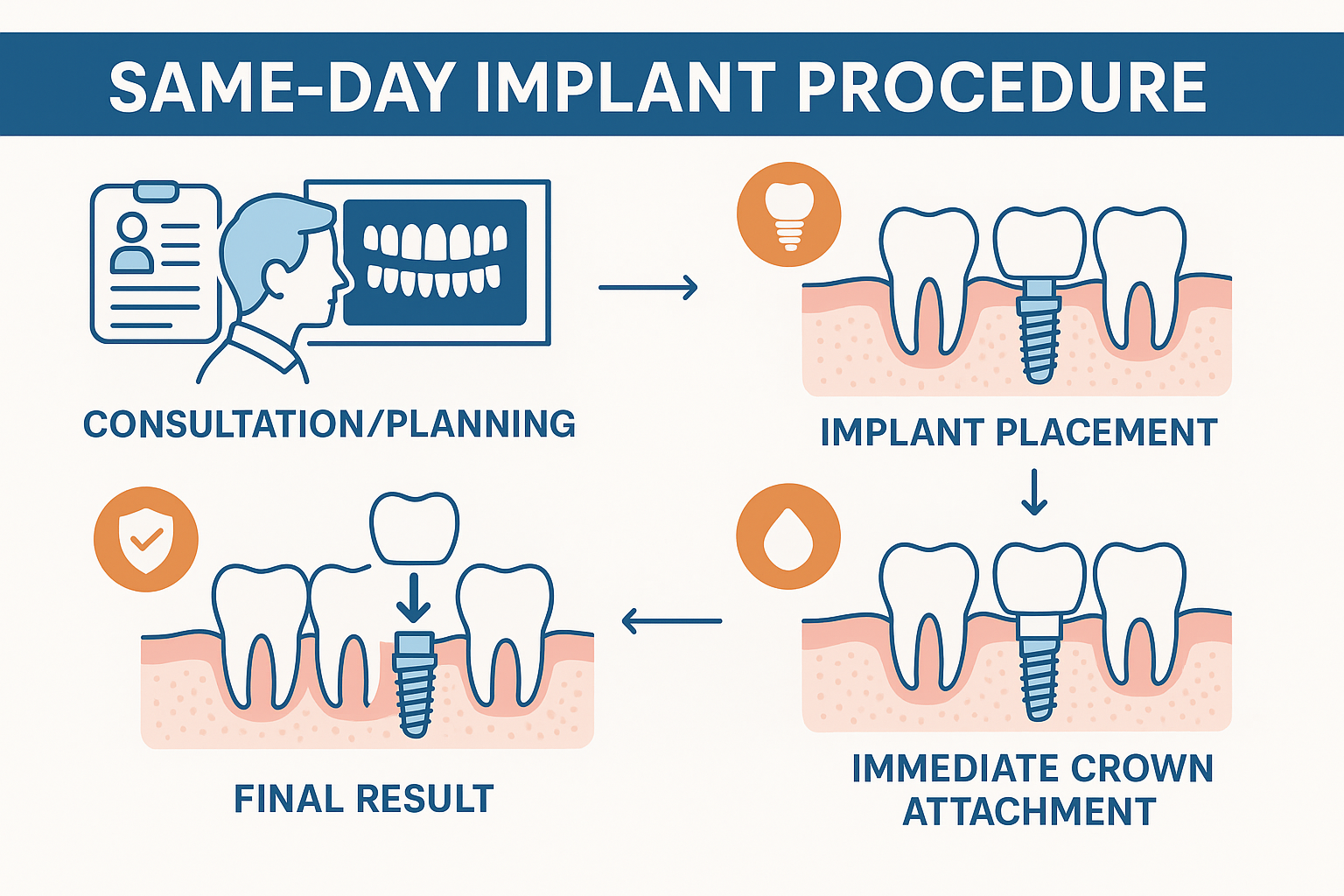
Pre-Procedure Planning 📋
Success with same-day implants begins with thorough planning. Your dental implant specialist will conduct:
- 3D imaging and CT scans to assess bone density and structure
- Digital impressions for precise crown fabrication
- Medical history review to identify any contraindications
- Bite analysis to ensure proper crown positioning
The Day of Surgery
Morning Preparation:
- Local anesthesia or sedation administration
- Final measurements and adjustments to treatment plan
Implant Placement (30-60 minutes):
- Site preparation: If extracting a tooth, this happens first
- Pilot hole creation: Precise drilling to accommodate the implant
- Implant insertion: The titanium post is carefully placed
- Torque testing: Ensuring adequate stability for immediate loading
Immediate Crown Placement (30-45 minutes):
- Abutment attachment: Connecting piece between implant and crown
- Crown fitting: Temporary crown is shaped and adjusted
- Bite adjustment: Ensuring comfortable and functional occlusion
- Final checks: Verifying stability and patient comfort
Expert Tip: “The key to successful same-day implants is achieving primary stability of at least 35 Ncm torque. This ensures the implant can handle the immediate functional load.” – Dr. Sarah Chen, Oral Surgeon
Who Is a Good Candidate for Same-Day Implants?
Ideal Candidates ✅
Bone Quality Requirements:
- Adequate bone density (Type 1, 2, or good Type 3 bone)
- Sufficient bone height and width
- No active bone disease or significant bone loss
Oral Health Factors:
- Good overall oral hygiene
- Healthy gums with no active periodontal disease
- No active infections at the implant site
- Non-smokers or those willing to quit during healing
General Health Considerations:
- Controlled diabetes (HbA1c < 7%)
- No autoimmune disorders affecting healing
- Not taking medications that impair bone healing
- Realistic expectations about the procedure
When Same-Day Implants May Not Be Suitable ❌
Bone-Related Contraindications:
- Insufficient bone density or volume
- Need for extensive bone grafting
- Active bone infections or cysts
Health-Related Factors:
- Uncontrolled diabetes
- Heavy smoking or tobacco use
- Certain medications (bisphosphonates, immunosuppressants)
- Pregnancy or breastfeeding
Site-Specific Issues:
- Active infection at extraction site
- Fractured roots requiring extensive removal
- Poor positioning for optimal crown placement
Same-Day Implant Candidacy Assessment
Benefits of Same-Day Implants
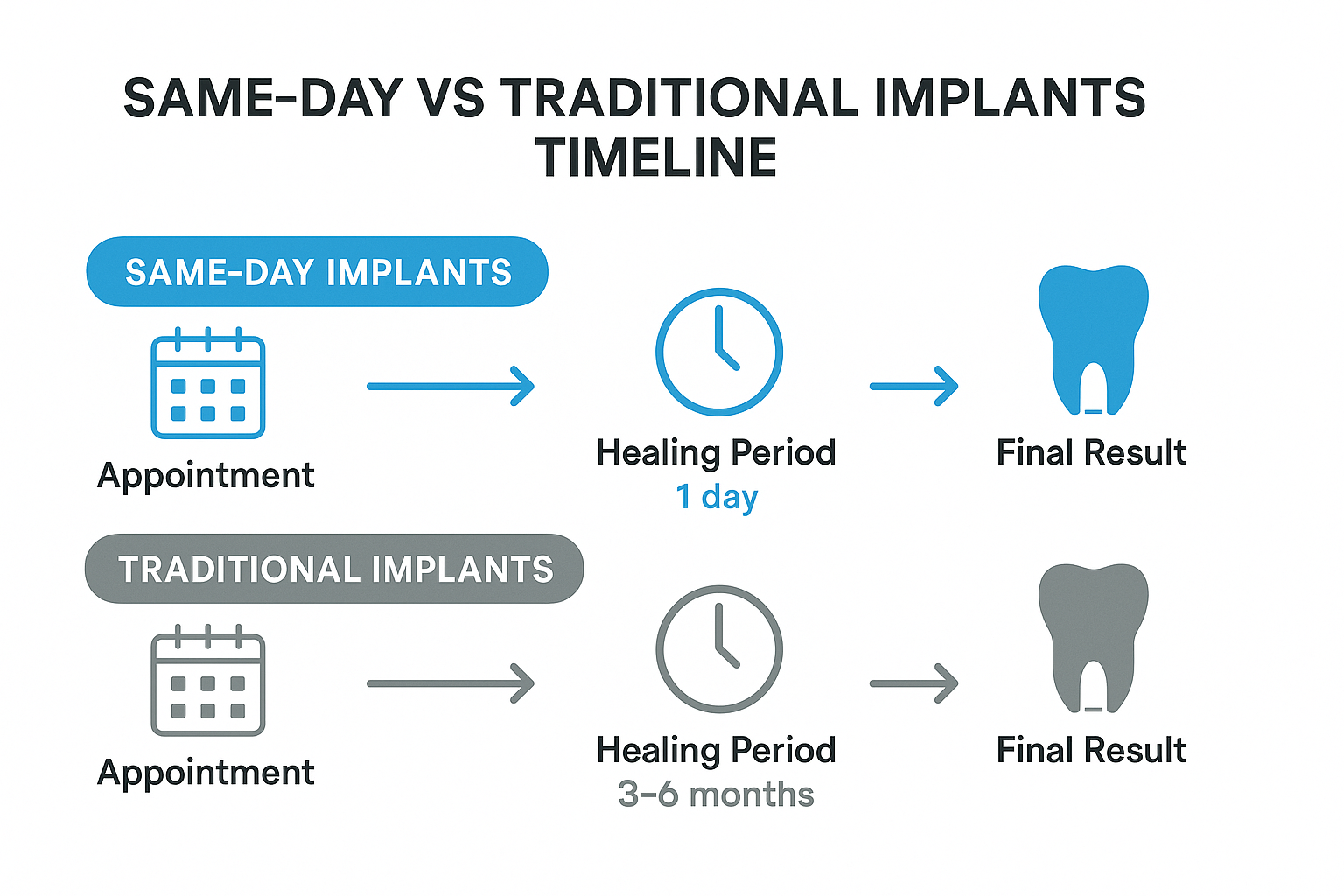
Immediate Functional Benefits 🚀
Instant Smile Restoration:
- Walk out with a complete smile the same day
- No embarrassing gaps or missing teeth
- Immediate confidence boost in social and professional situations
Preserved Facial Structure:
- Maintains proper facial support and muscle tone
- Prevents the sunken appearance that can develop with missing teeth
- Preserves natural lip and cheek positioning
Immediate Function:
- Ability to eat soft foods immediately (with restrictions)
- Normal speech patterns maintained
- No adjustment period to missing teeth
Long-Term Advantages
Bone Preservation:
- Immediate stimulation helps maintain jawbone density
- Reduces long-term bone loss compared to leaving sites empty
- Better long-term facial aesthetics
Cost Efficiency: When considering factors affecting implant cost in Dallas, same-day implants can offer savings through:
- Fewer office visits and appointments
- Reduced time off work
- No need for temporary partial dentures
- Single anesthesia session
Psychological Benefits:
- Reduced anxiety from shorter treatment timeline
- Maintained self-confidence throughout healing
- Less disruption to daily life and routines
Potential Risks and Limitations
Understanding the Challenges ⚠️
Higher Initial Failure Risk:
- Slightly higher risk of implant failure in first 3 months
- Risk of overloading implant during initial healing
- Importance of following post-operative instructions
Technical Limitations:
- Not suitable for all anatomical situations
- Requires precise case selection
- May need revision if complications arise
Healing Considerations:
- Temporary crown may need adjustments
- Dietary restrictions during initial healing
- Potential for minor complications during integration
Minimizing Risks
Proper Case Selection: Working with experienced dental implant specialists ensures:
- Thorough pre-operative evaluation
- Appropriate case selection criteria
- Advanced surgical techniques
Post-Operative Care:
- Strict adherence to dietary guidelines
- Regular follow-up appointments
- Proper oral hygiene protocols
- Immediate attention to any concerns
Cost Considerations for Same-Day Implants
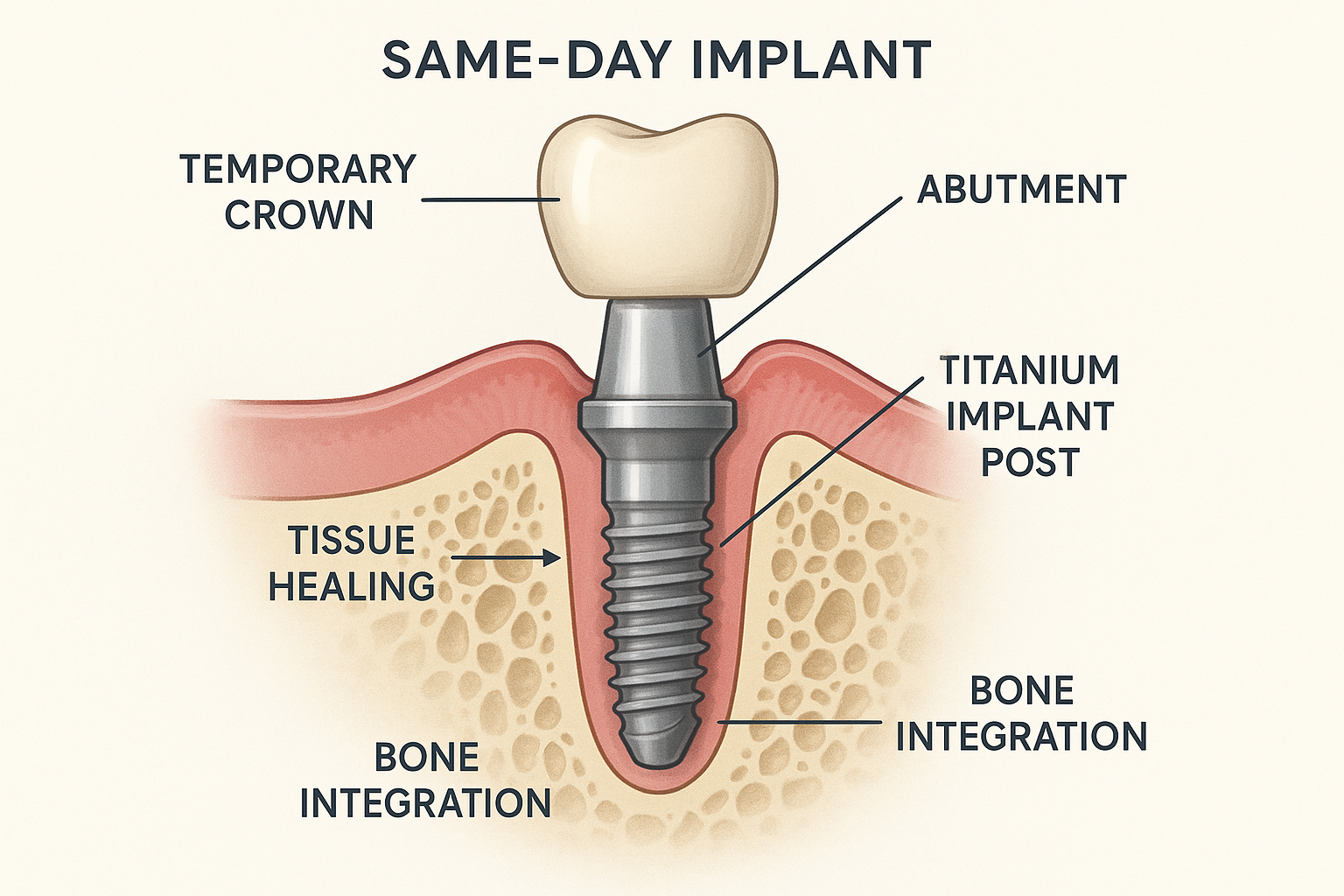
Investment Breakdown 💰
Initial Costs:
- Consultation and imaging: $200-$500
- Same-day implant procedure: $3,000-$6,000
- Temporary crown included in procedure cost
- Final crown placement: $1,000-$2,000
Comparing Total Investment: While the upfront cost may seem higher, consider the total value:
| Factor | Same-Day Implants | Traditional Implants |
|---|---|---|
| Procedure Visits | 2-3 appointments | 4-6 appointments |
| Time Off Work | 1-2 days | 3-5 days |
| Temporary Solutions | Not needed | $300-$800 |
| Total Timeline | 3-4 months | 6-8 months |
Financial Planning Options
For those seeking affordable dental implants in Dallas, several options exist:
Insurance Coverage:
- Some dental insurance covers portion of implant costs
- Medical insurance may cover implants for trauma cases
- HSA/FSA accounts can be used for implant procedures
Financing Solutions: Many practices offer payment plans for implants in Dallas:
- 0% interest financing options
- Extended payment plans
- Third-party financing companies
- In-house payment arrangements
Recovery and Aftercare
Immediate Post-Procedure Care (First 24-48 Hours) 🏥
Pain Management:
- Over-the-counter pain relievers as directed
- Ice packs for swelling reduction (20 minutes on, 20 off)
- Prescription pain medication if needed
- Avoid aspirin which can increase bleeding
Dietary Guidelines:
- First 24 hours: Liquids and very soft foods only
- Days 2-7: Soft diet (yogurt, smoothies, pasta, soft fish)
- Weeks 2-4: Gradually introduce firmer foods
- Avoid: Hard, crunchy, sticky, or very hot foods
Oral Hygiene Protocol:
- Gentle rinsing with salt water (after 24 hours)
- Soft-bristled toothbrush around implant area
- Avoid vigorous rinsing or spitting
- Continue normal brushing of other teeth
Long-Term Recovery Timeline
Week 1-2: Initial Healing
- Swelling peaks around day 2-3, then subsides
- Temporary crown adjustments if needed
- Return to work typically possible after 1-2 days
- Follow-up appointment to check healing
Month 1-3: Osseointegration
- Bone begins growing around implant
- Temporary crown remains functional
- Regular check-ups to monitor progress
- Gradual return to normal diet
Month 3-6: Final Restoration
- Osseointegration complete
- Final crown impressions and placement
- Full function and normal diet resumed
- Long-term maintenance begins
Signs to Watch For 🚨
Normal Healing Signs:
- Mild swelling for 3-5 days
- Some bruising around surgical site
- Minor bleeding first 24 hours
- Temporary sensitivity
When to Call Your Dentist:
- Severe pain not controlled by medication
- Excessive bleeding beyond 24 hours
- Signs of infection (fever, pus, increasing pain)
- Loose or displaced temporary crown
- Persistent numbness beyond expected timeframe
Choosing the Right Provider
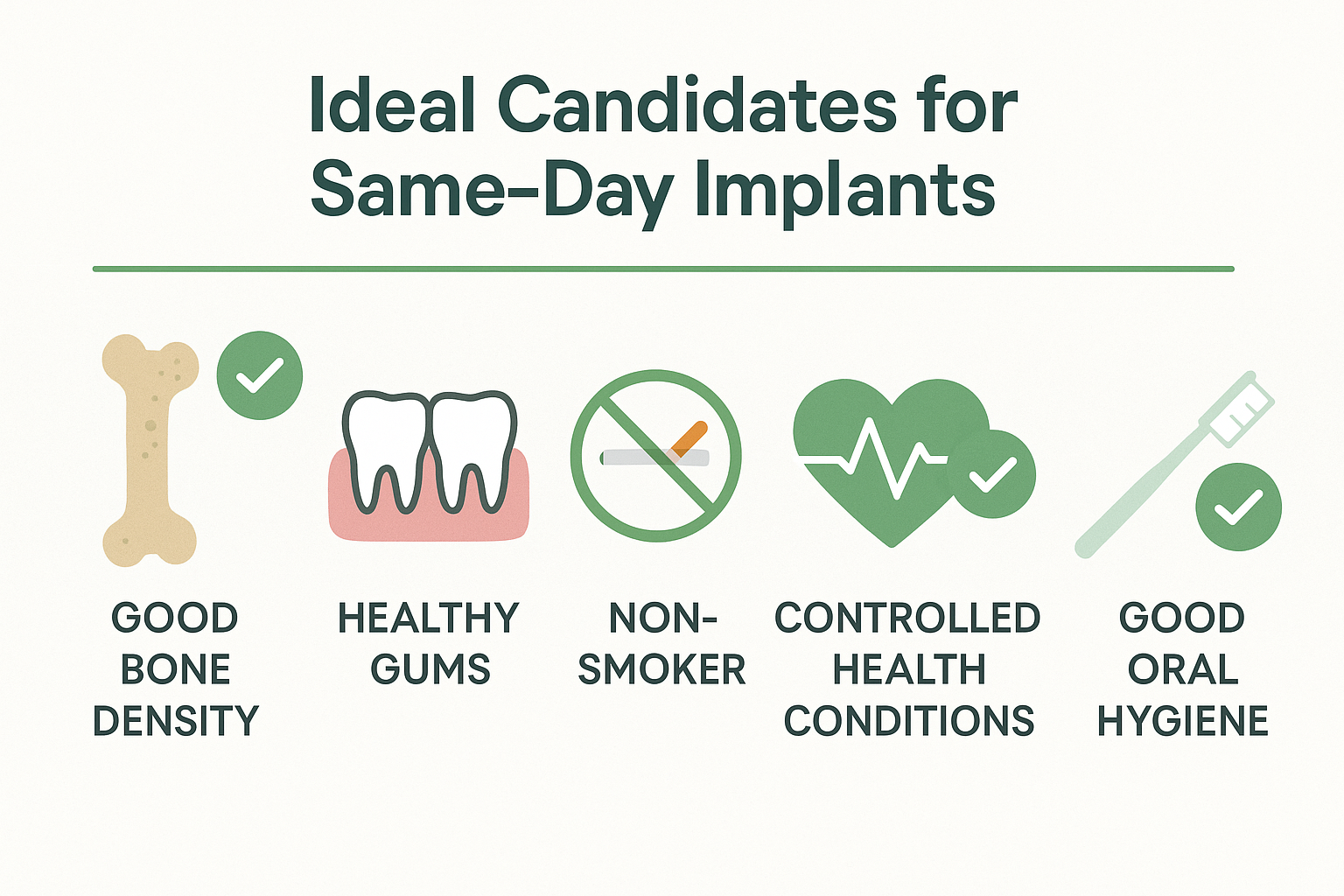
Essential Qualifications 🎓
Educational Background:
- Doctor of Dental Surgery (DDS) or Doctor of Dental Medicine (DMD)
- Specialized training in oral surgery or periodontics
- Continuing education in implant dentistry
- Board certifications in relevant specialties
Experience Factors:
- Minimum 100+ implant cases annually
- Specific experience with immediate load protocols
- Success rates and patient testimonials
- Before/after case examples
Technology and Facilities:
- 3D imaging and CT scan capabilities
- Computer-guided surgery systems
- On-site crown fabrication lab
- Sterile surgical suite
Questions to Ask Potential Providers
When learning how to choose a dental implant dentist, consider these key questions:
About Experience:
- How many same-day implants do you place annually?
- What is your success rate with immediate load implants?
- Can you provide references from recent patients?
- What happens if complications arise?
About the Procedure:
- Am I a good candidate for same-day implants?
- What type of implant system do you use?
- How long will the temporary crown last?
- What are the dietary restrictions?
About Costs and Financing:
- What is included in the quoted price?
- What financing options are available?
- Do you accept my insurance?
- What are the costs if additional procedures are needed?
Same-Day Implants vs. Traditional Implants: Making the Decision
When Same-Day Implants Are Preferred
Ideal Scenarios:
- Professional demands: Public-facing careers requiring complete smile
- Social events: Weddings, graduations, important presentations
- Psychological factors: High anxiety about extended treatment
- Single tooth replacement in aesthetic zone
- Fresh extraction sites with adequate bone
When Traditional Implants May Be Better
Complex Cases:
- Significant bone grafting requirements
- Multiple implant placements
- Compromised healing capacity
- High bite forces (heavy grinders)
- Aesthetic zone requiring perfect gum architecture
Decision-Making Framework
| Factor | Same-Day Priority | Traditional Priority |
|---|---|---|
| Bone Quality | Excellent (Type 1-2) | Any type with grafting |
| Aesthetic Demands | Moderate to high | Extremely high |
| Time Constraints | Very important | Flexible timeline |
| Healing Capacity | Excellent | Any level |
| Bite Forces | Normal | Heavy/grinding |
Success Rates and Long-Term Outcomes
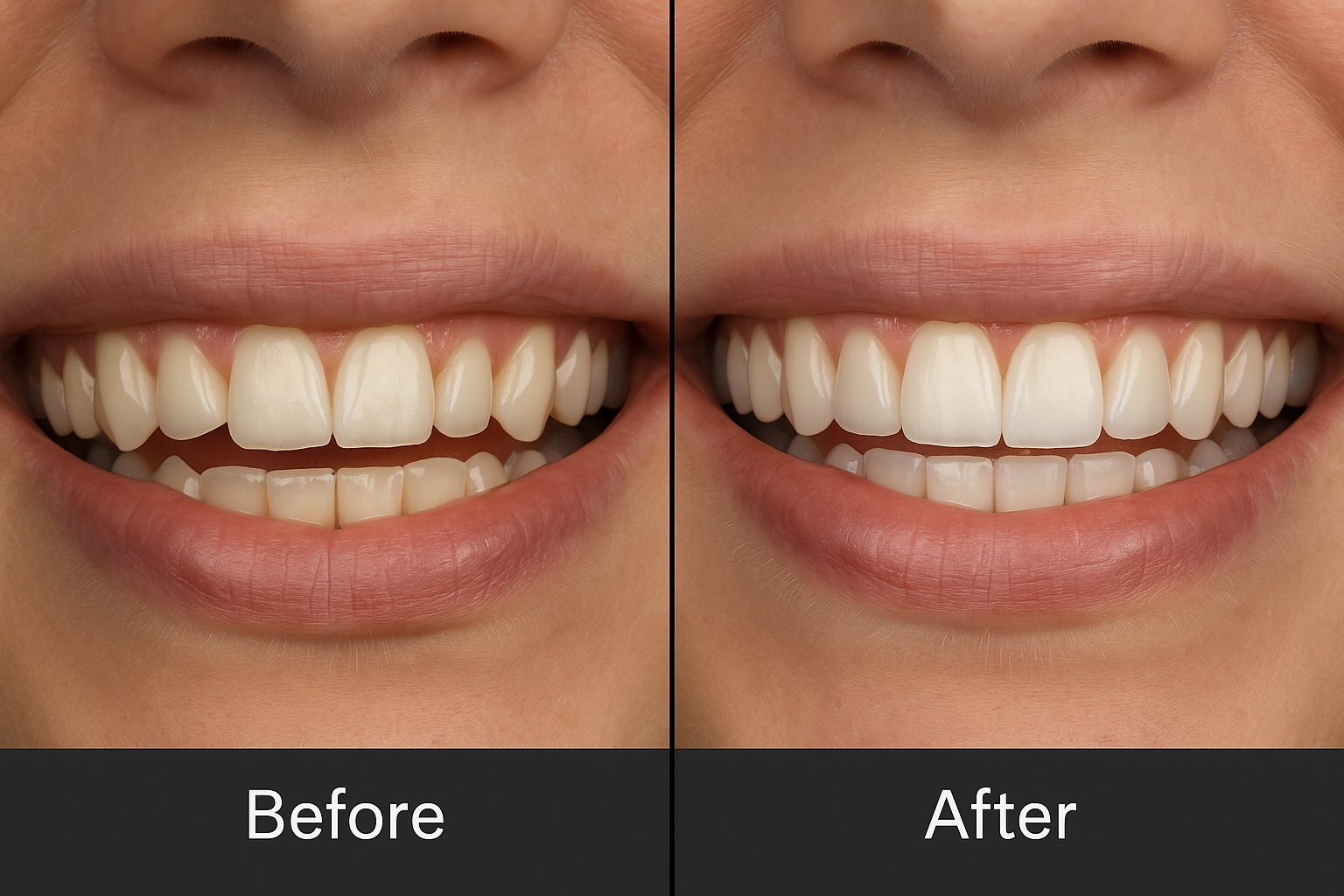
Clinical Research Data 📊
Short-Term Success (1 Year):
- Same-day implants: 95-98% success rate
- Traditional implants: 97-99% success rate
- Difference primarily in first 3 months
Long-Term Success (5+ Years):
- Same-day implants: 92-95% success rate
- Traditional implants: 94-97% success rate
- Outcomes converge with proper case selection
Factors Affecting Success
Patient-Related Factors:
- Bone quality and quantity (most important)
- Oral hygiene compliance
- Smoking status (significantly impacts success)
- Medical conditions (diabetes, autoimmune disorders)
- Age and healing capacity
Procedure-Related Factors:
- Primary stability achievement (>35 Ncm torque)
- Proper case selection
- Surgeon experience and technique
- Implant system quality
- Post-operative care compliance
Special Considerations and Advanced Cases
Multiple Same-Day Implants
Full Arch Restoration:
- “All-on-4” or “All-on-6” protocols
- Requires precise planning and execution
- Higher complexity but excellent outcomes
- Significant cost savings compared to individual implants
Partial Arch Replacement:
- 2-4 implants supporting multiple crowns
- Bridge-type restorations
- Reduced number of implants needed
- Faster healing than individual placements
Extraction and Immediate Implant Placement
Fresh Extraction Sites:
- Best candidate scenarios for same-day implants
- Preserves socket architecture
- Minimal additional trauma
- Faster overall healing timeline
Infected Sites:
- Require careful evaluation
- May need antibiotic pre-treatment
- Success rates slightly lower
- Alternative timing may be recommended
Future of Same-Day Implant Technology
Emerging Technologies 🔬
Digital Workflow Integration:
- 3D printing of surgical guides
- CAD/CAM crown fabrication in-office
- Virtual reality planning for complex cases
- AI-assisted treatment planning
Advanced Materials:
- Zirconia implants for metal-free solutions
- Surface modifications for faster integration
- Growth factor applications to enhance healing
- Bioactive coatings for improved outcomes
Minimally Invasive Techniques:
- Flapless surgery protocols
- Computer-guided placement
- Piezoelectric surgery for precise bone work
- Laser-assisted healing protocols
Research Developments
Current Studies Focus:
- Optimizing loading protocols
- Improving success in challenging cases
- Reducing healing times further
- Enhancing patient comfort
Frequently Asked Questions
Common Patient Concerns
Q: How painful is the same-day implant procedure? A: Most patients report mild to moderate discomfort, similar to a tooth extraction. Advanced anesthesia techniques and pain management protocols minimize discomfort during and after the procedure.
Q: Can I eat normally right after same-day implant placement? A: You’ll need to follow a soft diet for the first few weeks. Liquids and very soft foods for the first 24-48 hours, gradually progressing to normal diet over 4-6 weeks.
Q: What if the implant fails? A: While rare with proper case selection, implant failure can occur. Most reputable practices offer guarantees or warranties, and failed implants can often be replaced successfully.
Q: How long does the temporary crown last? A: Temporary crowns typically last 3-6 months until the final restoration is placed. They’re designed to be functional but may have some limitations compared to the final crown.
Q: Can I get same-day implants if I have gum disease? A: Active gum disease usually needs to be treated first. However, mild gingivitis that’s well-controlled may not prevent same-day implant placement with proper protocols.
Conclusion
Same-day implants represent a remarkable advancement in dental technology, offering patients the opportunity to restore their smile and function in a single appointment. While not suitable for every case, when properly selected and executed by experienced professionals, they provide excellent outcomes with the added benefit of immediate gratification.
The key to success lies in thorough evaluation, proper case selection, and choosing an experienced provider who understands the nuances of immediate load protocols. For qualified candidates, same-day implants offer a life-changing solution that eliminates the traditional waiting period and provides immediate restoration of confidence and function.
If you’re considering tooth replacement options, consult with a qualified dental implant specialist to determine if same-day implants are right for your specific situation. With proper planning and execution, you could be walking out with a new tooth the same day you walk in.
Next Steps 📝
- Schedule a consultation with an experienced implant dentist
- Complete necessary imaging (3D CT scan, X-rays)
- Discuss financing options and treatment timeline
- Review your candidacy using the assessment tool above
- Plan your procedure around your schedule and healing needs
Remember, investing in your oral health is investing in your overall quality of life. Same-day implants make that investment more convenient and immediate than ever before.

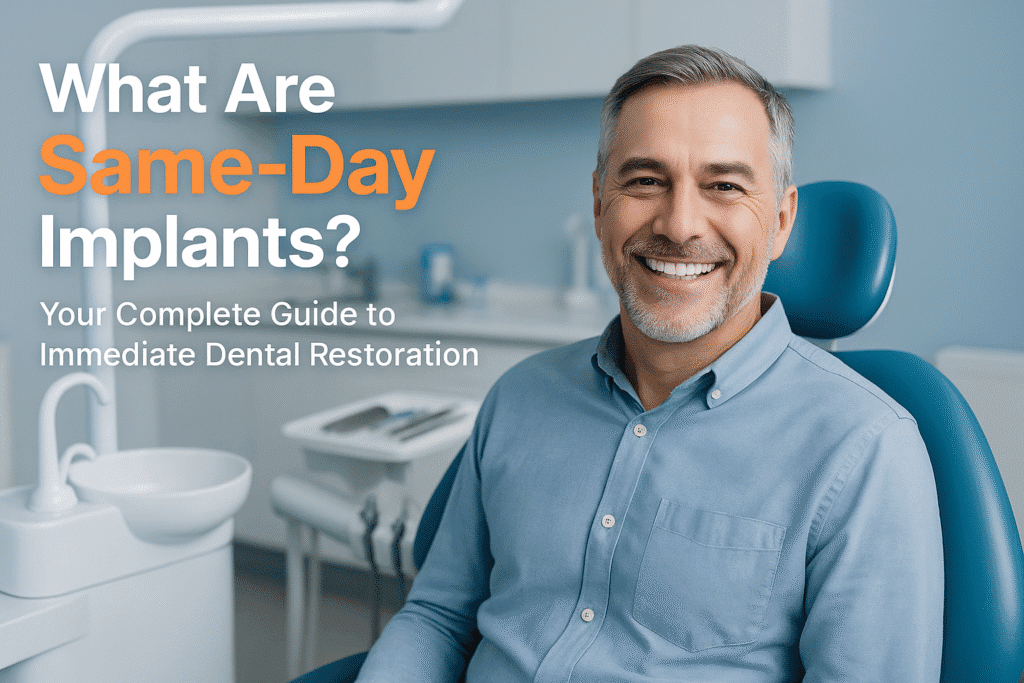
Leave a Reply
Share your thoughts or ask a question about dental implants. Your email address will not be published.